Synthetic Intelligence (AI) is likely one of the most fun and transformative fields in expertise right this moment. It refers back to the creation of machines and software program that may carry out duties sometimes requiring human intelligence, similar to understanding language, recognizing patterns, studying from expertise, and making choices. AI is revolutionizing numerous industries, from healthcare and finance to transportation and leisure, and its affect continues to increase quickly.
On this complete information, we are going to clarify what AI is, the way it works, the various kinds of AI, and the various functions of AI in our each day lives. Whether or not you’re utterly new to AI or seeking to increase your information, this information will present a stable understanding of the fundamentals, key ideas, and real-world examples of synthetic intelligence, together with how AI app builders are shaping modern options throughout industries.
What’s AI?
Synthetic Intelligence (AI) refers back to the discipline of pc science that goals to create machines or programs able to performing duties that sometimes require human intelligence. These duties embrace reasoning, studying, problem-solving, notion, language understanding, and decision-making. Merely put, AI allows machines to simulate human-like capabilities, permitting them to carry out actions with out specific programming.
At its core, AI seeks to develop programs that may assume, study, adapt, and act autonomously, typically in ways in which mimic human habits or enhance upon it. AI programs can course of massive quantities of knowledge, acknowledge patterns, and make knowledgeable choices quicker than people, making them extremely helpful throughout numerous industries, from healthcare to finance, and even leisure.
Key Elements of AI:
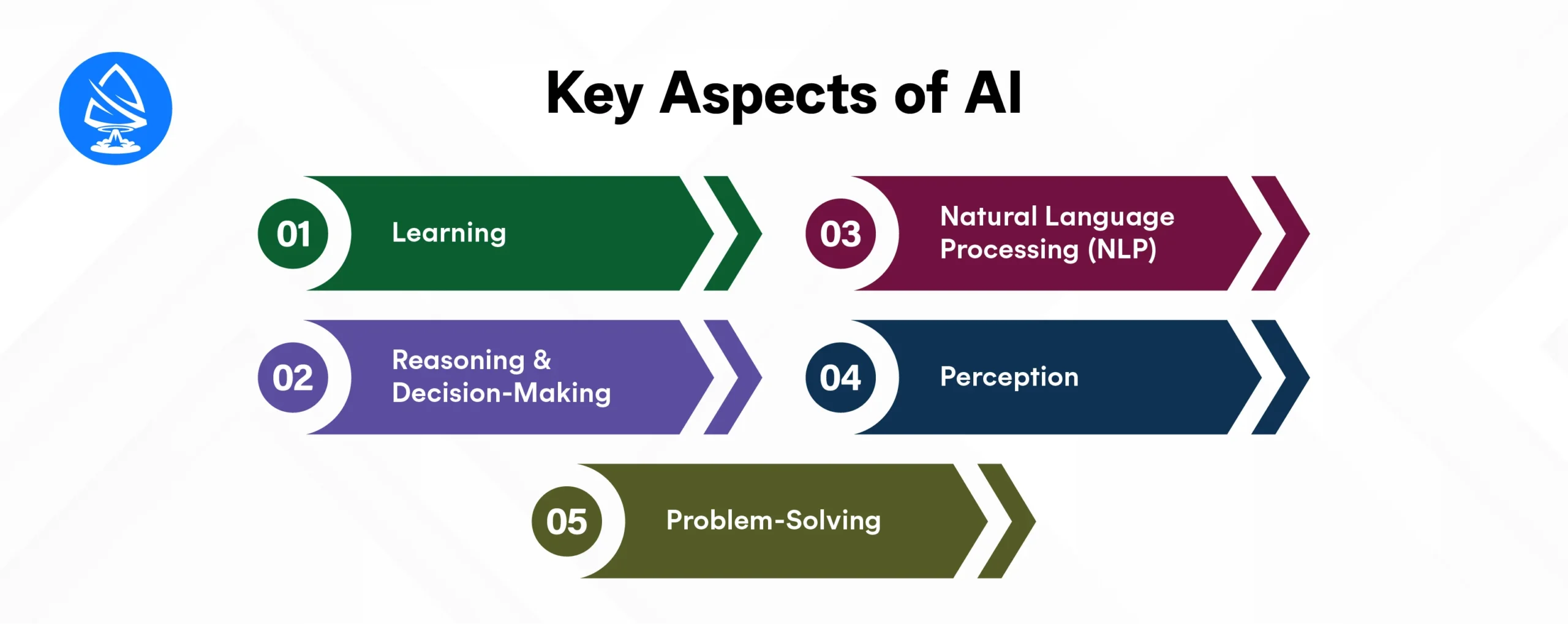
- Studying: AI programs study from information and expertise, permitting them to make predictions, acknowledge patterns, and adapt to new conditions. That is the premise of machine studying (ML), a subset of AI that permits programs to enhance routinely as they course of extra information.
- Reasoning and Resolution-Making: AI is able to analyzing information, figuring out relationships, and making choices primarily based on that evaluation. This functionality is important for duties like taking part in chess, driving a self-driving automobile, or figuring out creditworthiness.
- Pure Language Processing (NLP): AI allows machines to grasp and generate human language. NLP permits AI programs to work together with people in a approach that feels intuitive, similar to by means of voice assistants like Siri or Alexa, which may perceive instructions and reply questions.
- Notion: AI programs are capable of interpret sensory data, similar to photographs, sounds, or textual content, in ways in which simulate human notion. For instance, pc imaginative and prescient permits AI to acknowledge objects in photographs, whereas speech recognition allows voice assistants to grasp spoken instructions.
- Downside-Fixing: AI programs are designed to deal with complicated issues, utilizing strategies similar to algorithms, optimization, and simulation. These programs can analyze massive units of knowledge to determine tendencies, resolve issues, and even suggest options that people might not have thought of.
How Does AI Work?
Understanding how AI works requires an exploration of the core applied sciences that allow machines to simulate human intelligence. Whereas AI might appear to be a posh and mystical idea, it may be damaged down into a number of key rules and parts that type the muse of AI programs. Basically, AI works through the use of algorithms and huge quantities of knowledge to make choices, study from experiences, and enhance over time.
Let’s discover the elemental elements of how AI works:
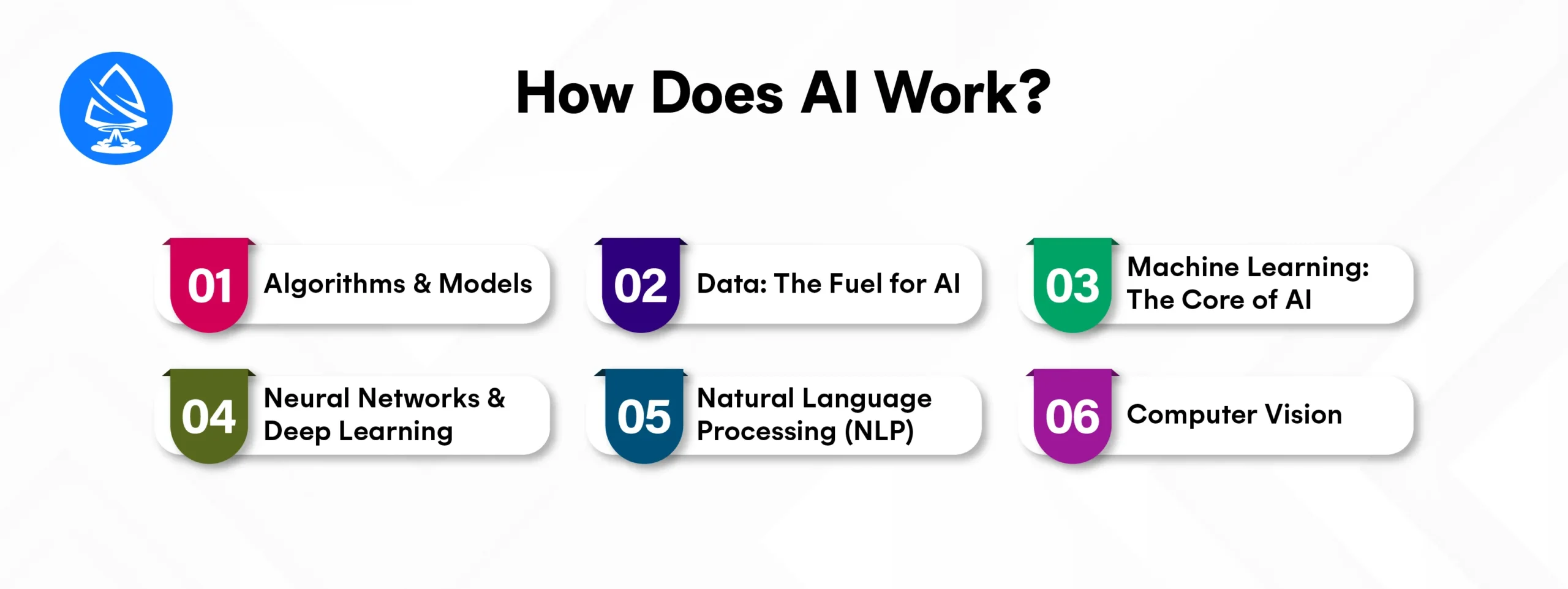
1. Algorithms and Fashions
On the coronary heart of each AI system lies an algorithm. An algorithm is a algorithm or directions designed to unravel an issue or carry out a particular job. These algorithms allow machines to course of information, study from it, and make predictions or choices. The complexity of AI algorithms varies, with some designed to deal with comparatively easy duties, whereas others are way more superior and able to fixing complicated issues, similar to these utilized in deep studying.
There are numerous varieties of algorithms utilized in AI, with the commonest being:
- Supervised Studying: In supervised studying, the algorithm is educated on labeled information, which suggests every information level is paired with the right reply. The AI mannequin learns to make predictions or choices by discovering patterns within the information and evaluating its predictions to the precise solutions. That is generally utilized in classification or regression duties.
- Unsupervised Studying: Not like supervised studying, unsupervised studying algorithms work with unlabeled information. These algorithms attempt to determine patterns or buildings throughout the information, similar to grouping comparable information factors (clustering) or decreasing the dimensionality of huge datasets.
- Reinforcement Studying: In reinforcement studying, an AI system learns by interacting with its surroundings and receiving suggestions within the type of rewards or penalties. The system adapts its habits primarily based on this suggestions to maximise cumulative rewards. That is generally utilized in functions similar to sport taking part in or robotics.
2. Information: The Gas for AI
Information is important for AI programs, because it gives the uncooked materials that the algorithms have to study and make choices. AI fashions are educated utilizing massive datasets, which permit them to acknowledge patterns, make predictions, and enhance over time. With out adequate and related information, AI programs can’t perform optimally.
For instance, an AI-powered picture recognition system is educated on hundreds of thousands of labeled photographs, which permits it to acknowledge patterns and make predictions on new, unseen photographs. The extra information an AI system is uncovered to, the higher its predictions will turn into, as it will possibly study from a wider vary of examples.
There are two major varieties of information utilized in AI:
- Structured Information: This refers to information that’s organized in a predefined format, similar to numbers, classes, or dates (e.g., spreadsheets or databases).
- Unstructured Information: That is information that doesn’t comply with a particular format, similar to textual content, photographs, audio, or video. AI fashions, particularly these in Pure Language Processing (NLP) and pc imaginative and prescient, work with unstructured information to interpret textual content or acknowledge objects in photographs.
3. Machine Studying: The Core of AI
Some of the important breakthroughs in AI is machine studying (ML), a subset of AI that permits machines to study from information with out being explicitly programmed. ML is the muse of many AI functions and permits programs to enhance routinely as they’re uncovered to new information.
Right here’s how machine studying works:
- Coaching: ML algorithms study from coaching information, which consists of examples that display the connection between enter and output. As an illustration, in a predictive mannequin, the enter is perhaps historic information (like buyer buy habits), and the output could possibly be the expected future habits (similar to probability to buy).
- Testing: As soon as the machine studying mannequin is educated on a dataset, it’s examined on a separate set of knowledge (known as check information) to guage its accuracy. This helps be sure that the mannequin can generalize to new, unseen information and isn’t simply memorizing the coaching information (which known as overfitting).
- Optimization: After testing, the mannequin is fine-tuned and optimized to enhance its efficiency, typically by adjusting the mannequin’s parameters (a course of known as hyperparameter tuning).
- Prediction: As soon as the mannequin is educated, examined, and optimized, it may be used to make predictions on new information, similar to predicting whether or not a buyer will purchase a product primarily based on their shopping historical past.
Key Subsets of Machine Studying:
- Supervised Studying: The mannequin learns from labeled information to foretell outcomes (e.g., classifying emails as spam or not spam).
- Unsupervised Studying: The mannequin learns from unlabeled information to find hidden patterns or buildings (e.g., clustering prospects primarily based on buying habits).
- Reinforcement Studying: The mannequin learns by interacting with an surroundings and receiving suggestions within the type of rewards or penalties.
4. Neural Networks and Deep Studying
A strong and superior subset of machine studying is deep studying, which makes use of neural networks to course of complicated information. Neural networks are computational fashions impressed by the construction of the human mind, consisting of layers of nodes (additionally known as neurons) related by hyperlinks.
Every neuron within the community receives enter, processes it, and passes the output to the subsequent layer. Deep studying entails coaching deep neural networks, which have a number of layers of neurons, permitting the mannequin to study hierarchical representations of knowledge. That is significantly efficient for duties like picture recognition, speech recognition, and pure language understanding.
Deep studying fashions require huge quantities of knowledge and important computational energy to coach, however they’ve demonstrated exceptional efficiency in complicated duties similar to:
- Picture classification: Recognizing objects inside photographs, similar to figuring out a cat in a photograph.
- Speech recognition: Changing spoken language into textual content or understanding spoken instructions.
- Pure language processing: Understanding and producing human language, enabling programs like chatbots or digital assistants.
5. Pure Language Processing (NLP)
One other crucial element of AI is Pure Language Processing (NLP), which allows machines to grasp, interpret, and generate human language. It’s utilized in functions similar to chatbots, voice assistants (like Siri and Alexa), and machine translation (similar to Google Translate).
NLP entails a number of sub-tasks, together with:
- Textual content evaluation: Extracting significant data from written textual content.
- Sentiment evaluation: Figuring out the sentiment or emotion behind a chunk of textual content (e.g., is a buyer evaluate optimistic or destructive?).
- Language era: Creating human-like textual content primarily based on enter (e.g., producing a abstract of a doc).
NLP is especially difficult as a result of complexity and ambiguity of human language, however AI algorithms and deep studying strategies have enabled important advances on this space.
6. Laptop Imaginative and prescient
Laptop imaginative and prescient is one other necessary AI expertise that enables machines to interpret and perceive visible data from the world. Utilizing deep studying fashions, pc imaginative and prescient programs can acknowledge and classify objects inside photographs and movies, detect faces, and even analyze scenes.
Frequent functions of pc imaginative and prescient embrace:
- Facial recognition: Figuring out or verifying people primarily based on facial options.
- Object detection: Recognizing particular objects (e.g., vehicles, individuals, animals) in photographs or movies.
- Autonomous autos: Utilizing pc imaginative and prescient to detect and perceive the encompassing surroundings for protected navigation.
You might also wish to know AI in Recruiting
Varieties of AI
AI may be categorized in a number of methods primarily based on its capabilities, performance, and the varieties of duties it’s designed to carry out. Understanding the various kinds of AI helps in comprehending its scope and potential functions throughout numerous industries. Broadly talking, AI may be divided into two important classes: primarily based on capabilities and primarily based on functionalities.
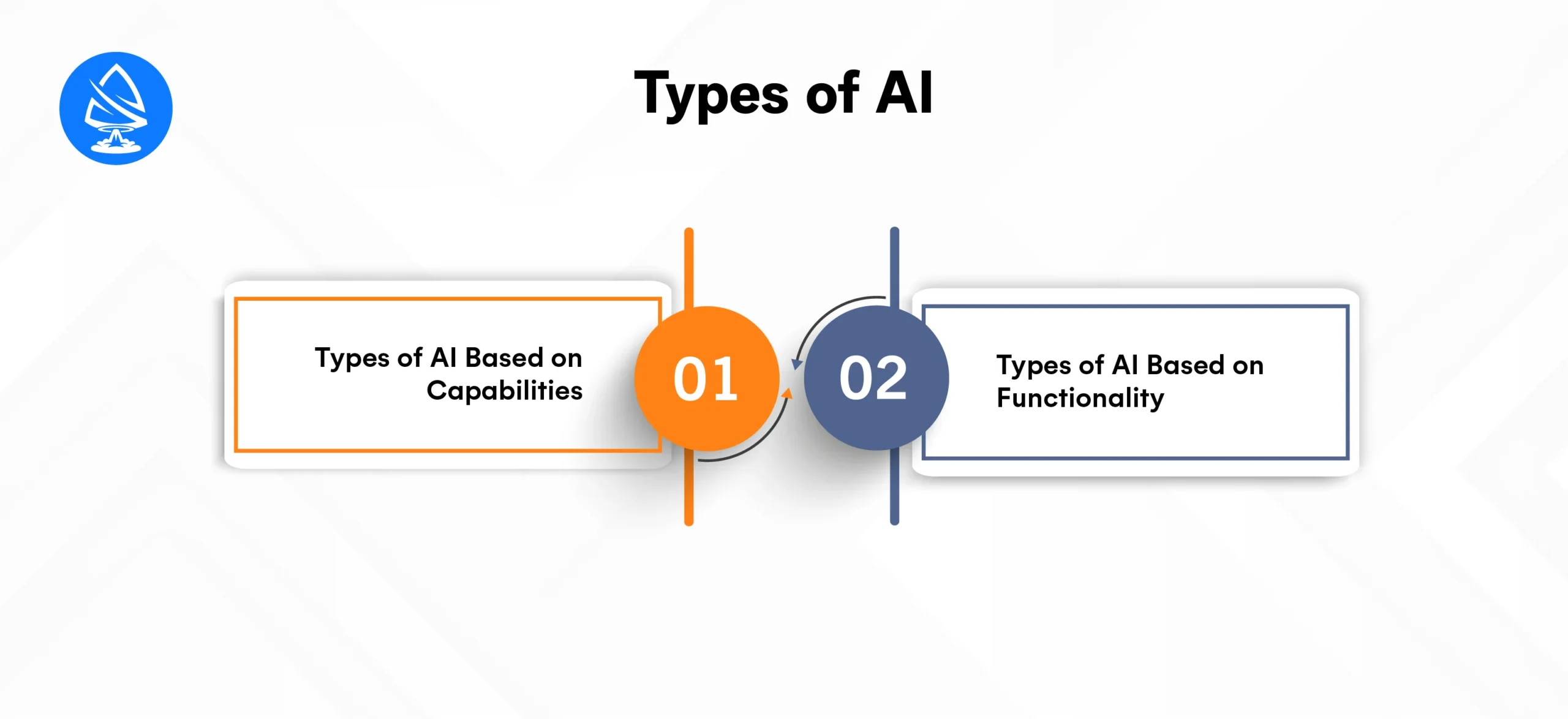
1. Varieties of AI Based mostly on Capabilities
When discussing AI primarily based on its capabilities, we sometimes seek advice from the extent of intelligence that the system possesses. The three generally acknowledged ranges are Synthetic Slender Intelligence (ANI), Synthetic Normal Intelligence (AGI), and Synthetic Superintelligence (ASI). Every stage represents a definite stage of sophistication and performance.
1.1 Synthetic Slender Intelligence (ANI) – Additionally Generally known as Weak AI
Synthetic Slender Intelligence (ANI), additionally known as Weak AI, is the commonest and extensively used type of AI right this moment. ANI is designed to carry out a particular job or resolve a selected drawback. It excels at finishing duties inside its outlined space however can’t carry out past its programming or perform.
Examples of ANI embrace:
- Voice assistants like Siri or Alexa can carry out particular duties similar to setting reminders or taking part in music.
- Advice programs utilized by Netflix, Spotify, and Amazon recommend content material or merchandise primarily based on earlier person habits.
- Picture recognition programs, similar to Google Photographs, routinely categorize and label photographs.
Regardless of ANI’s specialised focus, it will possibly nonetheless obtain exceptional ranges of efficiency inside its scope, typically surpassing human skills in that particular space.
1.2 Synthetic Normal Intelligence (AGI) – Additionally Generally known as Sturdy AI
Synthetic Normal Intelligence (AGI), also called Sturdy AI, is the hypothetical idea of AI that may perceive, study, and apply information throughout a variety of duties, very like a human being. AGI would have the ability to purpose, resolve complicated issues, and adapt to new conditions while not having to be programmed explicitly for every job.
Presently, AGI stays theoretical, and no system has achieved this stage of intelligence. Nevertheless, researchers are actively working towards creating AGI to create machines that may assume, perceive, and study throughout numerous domains.
Potential Functions of AGI:
- Autonomous problem-solving in complicated environments, similar to decision-making in unpredictable situations.
- Human-like robots that may carry out a wide range of duties, from cooking to aiding with medical surgical procedures, and adapting to new conditions as they come up.
1.3 Synthetic Superintelligence (ASI)
Synthetic Superintelligence (ASI) refers to an AI that surpasses human intelligence in each facet reasoning, creativity, social understanding, and emotional intelligence. ASI would have the ability to outperform the most effective human minds in any discipline, from scientific analysis to inventive creativity.
Though ASI continues to be a theoretical idea and the way forward for its growth is a topic of debate, it represents the top of AI evolution. Some consultants warn that ASI may result in dramatic penalties, as machines with superintelligence is perhaps past human management or understanding.
Key Traits of ASI:
- The power to assume, perceive, and function past human cognitive capabilities.
- Enhanced creativity and innovation, producing options and ideas far past human attain.
- Potential to carry out complicated duties autonomously, from scientific analysis to decision-making on a world scale.
2. Varieties of AI Based mostly on Performance
AI may also be labeled based on the kind of job it’s designed to carry out. Based mostly on performance, AI programs fall into the classes of Reactive Machines, Restricted Reminiscence, Principle of Thoughts, and Self-Conscious AI. Every of those classes represents an growing stage of sophistication by way of understanding, decision-making, and autonomy.
2.1 Reactive Machines
Reactive Machines are probably the most primary sort of AI, designed to carry out particular duties by reacting to stimuli or enter. These machines don’t have reminiscence or the flexibility to study from previous experiences. They’re programmed to reply to explicit inputs with predefined actions.
Examples of Reactive Machines:
- IBM’s Deep Blue: A chess-playing pc that was capable of defeat world champion Garry Kasparov. It may calculate attainable strikes and counter-moves, however had no reminiscence of previous video games.
- Spam Filters: Fundamental e mail filtering programs that react to sure key phrases or patterns to determine spam messages.
Reactive machines can solely concentrate on one job and don’t have the aptitude to enhance or adapt primarily based on earlier experiences.
2.2 Restricted Reminiscence
Restricted Reminiscence AI is extra superior than reactive machines. These programs can have a look at historic information and use it to make choices or predictions about future occasions. Restricted reminiscence refers back to the capacity of AI programs to make use of previous experiences to boost their efficiency on duties over time.
Many machine studying algorithms, particularly these utilized in predictive modeling, belong to this class. These programs are able to studying from information and bettering their efficiency with out being explicitly programmed for each state of affairs.
Examples of Restricted Reminiscence AI:
- Self-driving vehicles: These autos use information from earlier journeys and sensor readings to navigate roads, keep away from obstacles, and predict visitors patterns.
- Advice algorithms: Techniques like Netflix or Amazon that observe your viewing or buying habits to offer tailor-made content material solutions.
2.3 Principle of Thoughts
Principle of Thoughts AI is a extra superior type of AI that’s nonetheless within the analysis section. This stage of AI would have the ability to perceive and course of feelings, intentions, and beliefs, much like how people can perceive one another’s ideas, feelings, and psychological states.
If AI had been to succeed in this stage, it may work together with people in a extra empathetic and nuanced approach. It may perceive human motivations and reply accordingly, enhancing areas like psychological well being assist, customer support, and human-robot interactions.
Potential Functions of Principle of Thoughts AI:
- Social robots that may perceive and work together with people in ways in which really feel pure and empathetic.
- Emotionally clever AI that might present customized recommendation and assist in healthcare or remedy.
2.4 Self-Conscious AI
Self-Conscious AI represents the last word aim of AI app growth companies: machines that possess self-awareness, consciousness, and feelings. These AI programs could be able to understanding their existence and reflecting on their ideas and actions. Nevertheless, self-aware AI is only theoretical and has not been achieved but.
If AI programs had been to turn into self-aware, they might probably make complicated choices, have interaction in introspection, and exhibit habits much like human cognition. This stage of AI would have profound moral implications and would elevate important questions on autonomy, rights, and obligations.
Key Traits of Self-Conscious AI:
- Means to grasp its existence and position on the planet.
- The capability for self-improvement and self-reflection.
- Feelings and decision-making processes that transcend primary logic and purpose.
Functions of Synthetic Intelligence
Synthetic Intelligence (AI) has far-reaching functions throughout a number of industries, driving innovation and effectivity. From healthcare and finance to transportation and leisure, AI helps companies automate processes, improve decision-making, and supply higher companies. With its capacity to research huge quantities of knowledge, acknowledge patterns, and make choices, AI is revolutionizing the way in which we dwell and work.
Listed here are a number of the key functions of synthetic intelligence in numerous industries:
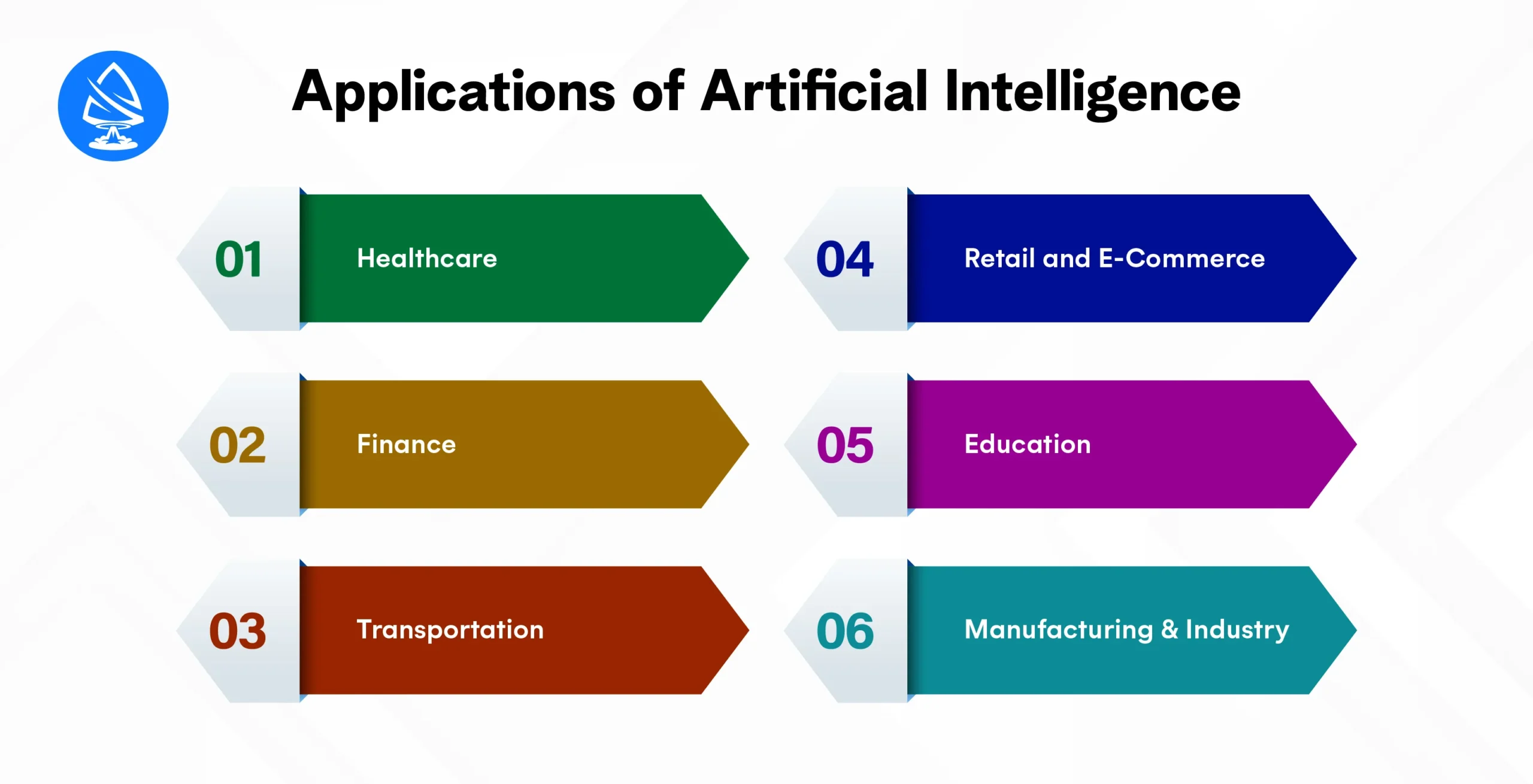
1. Healthcare
AI is reworking healthcare by enabling extra environment friendly diagnoses, customized remedy plans, and bettering affected person outcomes. With entry to huge medical datasets, AI programs can help healthcare professionals in making extra correct choices, diagnosing illnesses at early phases, and figuring out potential well being dangers.
Key AI Functions in Healthcare:
- Medical Imaging and Diagnostics: AI algorithms can analyze medical photographs (e.g., X-rays, MRIs) to detect abnormalities like tumors, fractures, or infections. AI-powered diagnostic instruments, similar to PathAI, help pathologists in diagnosing illnesses like most cancers extra precisely.
- Predictive Analytics: AI fashions can analyze affected person information and predict future well being dangers, similar to coronary heart illness or diabetes, permitting for earlier intervention.
- Robotic Surgical procedure: AI-powered surgical robots help surgeons in performing complicated procedures with higher precision, decreasing restoration instances and minimizing errors.
- Customized Drugs: AI helps tailor therapies to particular person sufferers primarily based on their genetic make-up, medical historical past, and way of life, resulting in more practical therapies.
Advantages:
- Improved accuracy in diagnostics and remedy suggestions.
- Sooner decision-making, enabling well timed interventions and coverings.
- Value discount by optimizing healthcare processes and decreasing the necessity for pointless checks.
2. Finance
The monetary trade has adopted AI to optimize numerous processes, from fraud detection to algorithmic buying and selling. AI-powered programs can analyze monetary information, acknowledge patterns, and make predictions quicker and extra precisely than people.
Key AI Functions in Finance:
- Fraud Detection: AI programs can monitor transactions in real-time to detect uncommon patterns and flag potential fraudulent actions. Machine studying algorithms can study from earlier information and adapt to new fraud techniques, decreasing the chance of economic fraud.
- Algorithmic Buying and selling: AI algorithms analyze market information and make commerce choices primarily based on patterns, tendencies, and real-time information. These programs can execute trades at a velocity and quantity that human merchants can’t match.
- Credit score Scoring: AI can consider creditworthiness by analyzing a wider vary of knowledge, together with transaction histories, social habits, and on-line exercise, offering a extra correct evaluation of a person’s or firm’s monetary reliability.
- Buyer Service: AI-driven chatbots and digital assistants in banking assist prospects with queries, transactions, and companies 24/7, enhancing buyer satisfaction and decreasing the necessity for human intervention.
Advantages:
- Sooner transactions and decision-making in monetary operations.
- Enhanced safety by means of superior fraud detection strategies.
- Customized monetary recommendation primarily based on particular person buyer information.
3. Transportation
AI is taking part in a pivotal position in reworking the transportation trade, significantly with the event of self-driving autos and sensible visitors programs. AI applied sciences similar to pc imaginative and prescient, sensor information processing, and machine studying are enabling autos to navigate roads autonomously and safely.
Key AI Functions in Transportation:
- Self-Driving Vehicles: Corporations like Tesla, Waymo, and Uber are creating autonomous autos that use AI to interpret their surroundings, make driving choices, and navigate roads safely. AI-powered programs use information from cameras, sensors, and radars to detect obstacles, pedestrians, and different autos.
- Site visitors Administration: AI is used to optimize visitors stream in sensible cities. AI algorithms can analyze real-time visitors information, modify visitors gentle timings, and handle congestion to enhance highway effectivity and cut back journey instances.
- Fleet Administration: AI helps logistics firms optimize their fleet operations by predicting upkeep wants, optimizing routes, and making certain well timed deliveries.
- Supply Drones: AI-powered drones are getting used for last-mile supply in e-commerce, permitting companies to ship packages quicker and extra effectively.
Advantages:
- Elevated security by means of autonomous driving programs that cut back human error.
- Environment friendly transportation programs that cut back congestion and enhance visitors stream.
- Value financial savings for logistics firms by means of optimized routes and predictive upkeep.
4. Retail and E-Commerce
AI has considerably improved the retail and e-commerce industries by enabling customized buying experiences, stock administration, and customer support automation. AI programs assist retailers perceive client habits, predict demand, and optimize pricing methods.
Key AI Functions in Retail and E-Commerce:
- Customized Suggestions: AI-powered advice programs, like these utilized by Amazon or Netflix, analyze buyer habits, buy historical past, and preferences to recommend merchandise, content material, or companies that prospects are more than likely to purchase.
- Chatbots and Digital Assistants: AI chatbots deal with buyer inquiries, help with on-line purchases, and supply assist 24/7, bettering the client expertise whereas decreasing operational prices.
- Stock Administration: AI programs assist retailers optimize inventory ranges, predict demand, and handle provide chains extra effectively by analyzing gross sales information and tendencies.
- Visible Search: AI-driven visible search engines like google enable prospects to seek for merchandise utilizing photographs as an alternative of textual content, making it simpler for them to search out precisely what they’re on the lookout for.
Advantages:
- Improved buyer engagement by means of customized suggestions and 24/7 assist.
- Elevated gross sales by suggesting merchandise tailor-made to particular person buyer preferences.
- Optimized stock administration and lowered stockouts or overstocking.
5. Schooling
AI is revolutionizing the schooling sector by enabling customized studying experiences, automating administrative duties, and offering helpful insights for each college students and lecturers.
Key AI Functions in Schooling:
- Customized Studying: AI-powered platforms like Khan Academy and Duolingo supply custom-made studying paths for college students, adapting content material and issue ranges primarily based on particular person efficiency and studying tempo.
- Automated Grading: AI programs can automate the grading of assignments and exams, significantly in topics with clear, goal solutions like arithmetic or multiple-choice questions, releasing up educators to concentrate on extra complicated duties.
- Digital Educating Assistants: AI-driven chatbots or digital tutors assist college students with their research, answering questions and offering explanations on numerous matters.
- Predictive Analytics: AI instruments analyze pupil information to foretell efficiency tendencies and determine college students who may have further assist or intervention earlier than they fall behind.
Advantages:
- Extra customized studying experiences that cater to every pupil’s wants.
- Time financial savings for educators by automating administrative duties like grading.
- Improved pupil outcomes by means of focused interventions and assist.
6. Manufacturing and Business
AI is driving the fourth industrial revolution by enabling smarter, extra environment friendly manufacturing processes. AI-powered programs assist optimize manufacturing traces, enhance high quality management, and allow predictive upkeep, making certain tools runs easily and decreasing downtime.
Key AI Functions in Manufacturing:
- Predictive Upkeep: AI programs analyze information from sensors embedded in equipment to foretell when a chunk of apparatus is prone to fail, permitting for preventative upkeep and decreasing sudden downtime.
- Robotic Course of Automation (RPA): AI-driven robots carry out duties similar to meeting, packaging, and high quality inspections. These robots can work quicker and extra precisely than people, decreasing prices and growing productiveness.
- Provide Chain Optimization: AI helps producers optimize their provide chains by predicting demand, managing stock, and selecting the right suppliers and logistics companions.
- High quality Management: AI-powered pc imaginative and prescient programs examine merchandise throughout manufacturing to make sure they meet high quality requirements, detecting defects that will go unnoticed by human inspectors.
Advantages:
- Lowered operational prices by means of automation and predictive upkeep.
- Elevated effectivity and productiveness in manufacturing processes.
- Larger-quality merchandise are because of AI-driven high quality management programs.
Ranges of Synthetic Intelligence
Consultants generally categorize Synthetic Intelligence (AI) into completely different ranges primarily based on its capabilities and the varieties of duties it will possibly carry out. They use these ranges to explain the vary of intelligence AI programs exhibit, from slim, task-specific AI to programs that might probably outperform human intelligence in each area. Understanding the completely different ranges of AI is important for greedy the broader implications of its growth and the potential future developments within the discipline.
The three major ranges of AI are Synthetic Slender Intelligence (ANI), Synthetic Normal Intelligence (AGI), and Synthetic Superintelligence (ASI). Every stage represents a distinct stage of AI’s functionality to copy or exceed human intelligence.
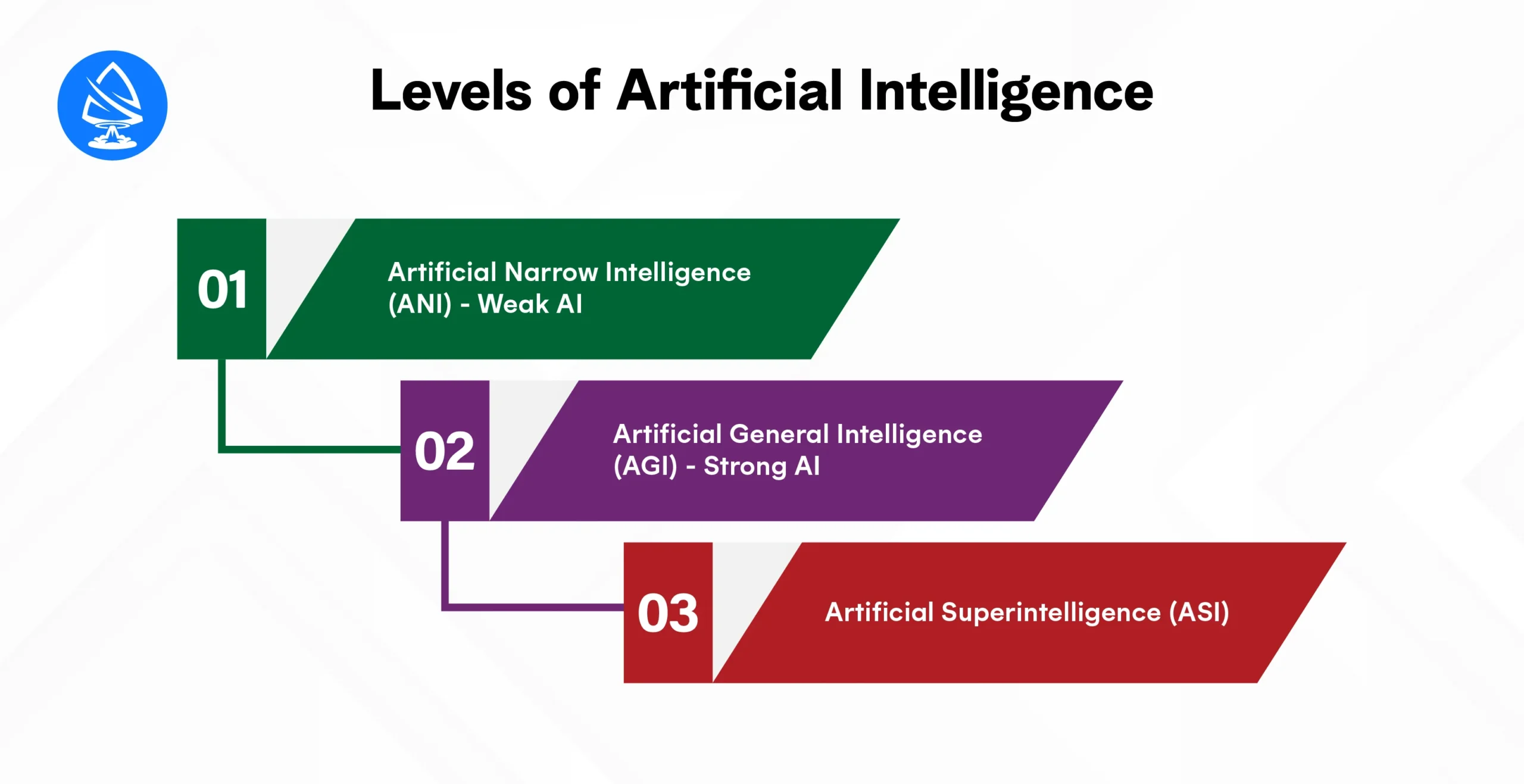
1. Synthetic Slender Intelligence (ANI) – Weak AI
Synthetic Slender Intelligence (ANI), additionally known as Weak AI, is the commonest sort of AI at present in use. ANI refers to AI programs which can be designed and educated to carry out a particular job or a slim set of duties. These programs excel at one job however can’t carry out duties outdoors their programming or adapt to duties that require common intelligence.
Examples of ANI embrace:
- Voice Assistants: Siri, Google Assistant, and Alexa are examples of ANI. They will carry out particular duties similar to setting reminders, making calls, or answering questions primarily based on pre-programmed features.
- Advice Techniques: Platforms like Netflix and Amazon use ANI to research your viewing or buying historical past and suggest new content material or merchandise tailor-made to your pursuits.
- Spam Filters: Electronic mail programs use AI to detect spam messages primarily based on sure key phrases and patterns.
- Self-driving vehicles: Whereas self-driving vehicles are fairly superior, they nonetheless depend on ANI to carry out particular duties, similar to lane-keeping, visitors detection, and navigation. They can not carry out duties outdoors these particular parameters.
Key Traits of ANI:
- Activity-Particular: ANI is designed for a single goal and can’t carry out duties outdoors of its programming.
- Lack of Normal Understanding: ANI doesn’t perceive ideas outdoors the scope of its job. It operates primarily based on predefined guidelines or machine studying fashions.
- Restricted to Slender Features: The system’s intelligence is confined to a slim vary of actions.
Though ANI is extremely efficient in its designated duties, it isn’t able to pondering or reasoning like a human. For instance, an AI that may play chess at a grandmaster stage can’t carry out easy duties outdoors its chess-playing perform.
2. Synthetic Normal Intelligence (AGI) – Sturdy AI
Synthetic Normal Intelligence (AGI), also called Sturdy AI, is a kind of AI that possesses the flexibility to grasp, study, and apply intelligence throughout all kinds of duties, very like a human being. Not like ANI, AGI programs usually are not restricted to a single perform; they’ll carry out duties that require a broader vary of reasoning, understanding, and adaptation.
AGI has the potential to:
- Study from Expertise: AGI can enhance over time by studying from all kinds of duties and experiences, identical to people do.
- Perceive Context: It may possibly grasp nuances and complexities in numerous environments, adapt to new conditions, and apply information from one job to a different.
- Purpose and Remedy Issues: AGI can method problem-solving with the flexibleness and creativity present in human pondering.
Key Traits of AGI:
- Versatility: AGI can carry out all kinds of mental duties while not having specific programming for every job.
- Human-Like Cognitive Talents: AGI programs would have the ability to purpose, perceive context, and apply logic in methods much like people.
- Adaptability: AGI may adapt to new, unexpected conditions, an important element of common intelligence.
Nevertheless, AGI continues to be within the realm of concept and analysis. Whereas researchers have made important progress in creating specialised AI programs (like machine studying and pure language processing), they haven’t but created a very common intelligence that may assume, purpose, and perceive like people.
Potential Influence of AGI:
- AGI may revolutionize each discipline, from healthcare and regulation to schooling and inventive industries.
- It may function a strong device for addressing complicated, world issues, similar to local weather change, financial inequality, and even house exploration.
Nevertheless, there are additionally moral and existential dangers related to AGI, as its capabilities may pose important challenges by way of management, accountability, and the potential for misuse.
3. Synthetic Superintelligence (ASI)
Synthetic Superintelligence (ASI) represents the top of AI growth. ASI refers to AI programs that exceed human intelligence in each attainable area—cognitive skills, creativity, emotional intelligence, and social understanding. Not like AGI, which goals to copy human intelligence, ASI is predicted to surpass human capabilities and outperform the most effective human minds in just about all duties, from scientific analysis to social interactions.
Key Traits of ASI:
- Surpasses Human Intelligence: ASI would outperform people in all mental fields, from complicated problem-solving to emotional understanding.
- Creativity and Innovation: ASI would have the flexibility to generate new concepts, invent applied sciences, and make breakthroughs in science and expertise quicker than people.
- Autonomous Resolution-Making: ASI may make choices by itself, probably resulting in self-improvement with out human intervention.
Potential Functions of ASI:
- Scientific Analysis: ASI may speed up analysis in numerous scientific fields, fixing issues which have plagued people for hundreds of years, similar to discovering cures for illnesses or understanding the universe.
- World Downside Fixing: ASI could possibly be used to handle world points similar to local weather change, poverty, and geopolitical conflicts by processing huge quantities of knowledge and offering data-driven options.
- Revolutionizing Industries: ASI may rework industries like finance, healthcare, and transportation, creating extremely environment friendly programs which can be optimized past human capability.
Dangers of ASI:
- Existential Menace: The rise of ASI presents an moral dilemma. If ASI turns into extra clever than people, there’s a concern that it may act in methods which can be dangerous to humanity.
- Autonomy and Management: Making certain that ASI stays underneath human management and operates with helpful intentions is a serious problem.
- Social and Financial Influence: The widespread adoption of ASI may result in important disruption in labor markets, with jobs being displaced by machines and AI programs.
Presently, ASI is only theoretical and exists solely in discussions about the way forward for AI. You will need to be aware that ASI could possibly be a long time or centuries away, relying on how AI analysis progresses.
Conclusion
AI is now not a futuristic idea; it’s reworking industries and reshaping how we dwell and work. From machine studying and pure language processing to AI-powered functions, synthetic intelligence is revolutionizing enterprise operations, healthcare, schooling, and extra. As AI expertise continues to evolve, its functions will increase even additional, providing new alternatives for companies to automate processes, make higher choices, and supply enhanced buyer experiences.
By understanding the basics of what AI is, its varieties, the way it works, and its huge vary of functions, you’re higher geared up to leverage AI for private {and professional} progress. As we proceed to embrace AI-driven applied sciences, the way forward for innovation appears extremely promising.
Incessantly Requested Questions
1. What’s AI?
AI (Synthetic Intelligence) refers back to the simulation of human intelligence processes by machines, enabling them to carry out duties similar to reasoning, studying, and decision-making.
2. How does AI work?
AI works through the use of algorithms and information to acknowledge patterns, make choices, and enhance over time. Machine studying fashions, neural networks, and NLP are some key applied sciences that energy AI.
3. What are the varieties of AI?
There are three important varieties of AI: Slender AI, which performs particular duties; Normal AI, which has human-like capabilities; and Superintelligent AI, which surpasses human intelligence.
4. What are some functions of AI?
AI is utilized in healthcare, finance, automotive, retail, schooling, and extra, with functions like automated buying and selling, AI chatbots, self-driving vehicles, and customized advertising.
5. What’s the distinction between AI and machine studying?
AI is the broader idea of machines simulating human intelligence, whereas machine studying (ML) is a subset of AI that permits machines to study from information and enhance with out specific programming.
6. What’s an AI algorithm?
An AI algorithm is a set of directions that information a machine to carry out a job, make predictions, or resolve issues by processing information.
7. How is AI utilized in recruitment?
AI is utilized in recruitment to automate candidate sourcing, screening, and interviews, enhancing effectivity, decreasing bias, and bettering candidate matching.
8. How can AI assist companies?
AI helps companies enhance decision-making, automate repetitive duties, improve buyer experiences, and optimize operations by analyzing information and predicting outcomes.




